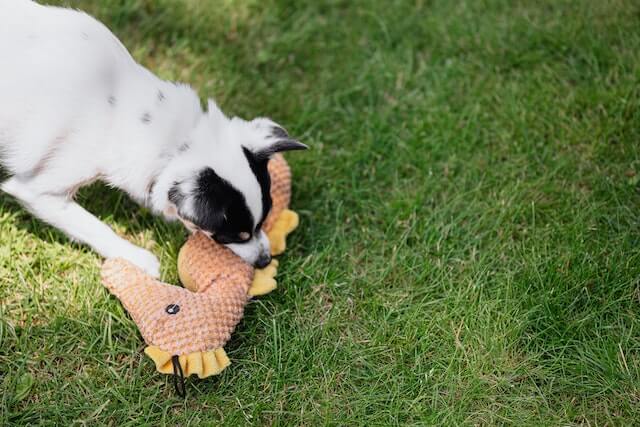What is a Dog Toy Allergy?
Dog toys are essential for your canine friend’s happiness and mental stimulation, but did you know they can also cause allergies? A dog toy allergy, although not extremely common, can lead to discomfort and health issues for your beloved pet.
How Common are Toy Allergies in Dogs?
Allergies, in general, are fairly common in dogs, with food allergies accounting for approximately 10% of all allergy cases. However, toy allergies, specifically those related to plastic or latex toys, can be challenging to diagnose due to the prevalence of these materials in various products. It’s important to note that dogs can develop allergies at any age and to any substance, including the materials found in their toys.
What are the Common Types of Dog Toy Allergies?
Latex allergies are one of the most common types of toy allergies in dogs. Many dog toys are made of latex, and dogs with a latex allergy may develop a rash and experience hair loss when they come into contact with these toys. Plastic allergies can also occur, although they’re less common.
What are the Symptoms of a Dog Toy Allergy?
The symptoms of a dog toy allergy can vary but often include skin issues such as rashes, itching, redness, and hair loss. In some cases, dogs may also experience gastrointestinal symptoms like vomiting or diarrhea if they ingest parts of the toy. If your dog shows any sign of an allergic reaction, it’s crucial to contact your vet immediately for advice.
How to Diagnose a Dog Toy Allergy?

As dog owners, we love spoiling our furry friends with an array of colorful toys. However, have you ever considered that your pup’s favorite plaything could be causing them discomfort or even making them sick? While not widely discussed, dog toy allergies are a real issue that can affect dogs of all breeds and ages.
The Problem and Its Causes
Dog toy allergies generally manifest as a reaction to certain materials used in the manufacturing of the toys, with latex being a common culprit. Many dog toys, particularly chew toys, are made from latex, which some dogs may develop an allergy to. When a dog with a latex allergy interacts with a toy made from this material, they may develop symptoms like rashes and hair loss.
In addition to latex, other materials like certain types of plastic can also cause allergies. However, these are less common. It’s also worth noting that stuffed toys can harbor dust mites, which could trigger allergies in dogs.
When Should You Take Your Dog to the Vet?
If your dog shows persistent signs of discomfort such as relentless scratching, hives, red skin, or any other unusual behavior after playing with a new toy, it’s time to consult your vet. These symptoms should not be ignored, as they indicate that your dog is experiencing discomfort and may need medical attention.
What Tests Does a Vet Perform to Diagnose a Toy Allergy?
When diagnosing a potential toy allergy, your vet will likely start by ruling out other common types of allergies, like food or environmental allergies. They may perform a physical examination and ask about your dog’s diet, environment, and the types of toys they play with. In some cases, they might recommend an elimination diet or conduct skin or blood tests to confirm the diagnosis.
Can Breeds Be More Prone to Toy Allergies?
While any dog can develop a toy allergy, certain breeds may be more susceptible due to their genetic predisposition to allergies in general. However, there isn’t enough research to conclusively link toy allergies to specific breeds.
How to Prevent Toy Allergies in Dogs

As dog owners, we all want our furry friends to be happy and healthy. We buy them the best food, give them plenty of exercise, and shower them with love and attention. One thing that often gets overlooked, however, is the potential for allergies – specifically, toy allergies. This post will provide actionable tips and advice on how to prevent toy allergies in dogs.
What Types of Toys are Safe for Dogs?
To prevent toy allergies, it’s important to choose toys made from materials that are less likely to cause an allergic responses. Rubber toys are often a safe bet, as they are durable and generally safe for dogs. Look for toys labeled as BPA-free, as BPA is a chemical found in many plastics that can cause allergic responses.
What are Some Alternatives to Common Allergenic Dog Toys?
If you suspect your dog is allergic to a certain type of toy, there are plenty of alternatives available. For instance, instead of latex toys, consider ones made from fabric, rope, or hard rubber. These materials are less likely to cause an allergic responses.
For dogs who love to chew, consider natural chew toys like rawhide or bully sticks. Just make sure to supervise your dog while they’re using these toys, as they can pose a choking hazard.
How to Keep Allergens Away from Your Dog’s Toys?
Keeping your dog’s toys clean can help reduce the risk of allergies. Wash fabric toys regularly in hot water and mild detergent, and rinse thoroughly. Hard toys can be cleaned with a mixture of vinegar and water.
Avoid letting your dog’s toys sit outside for long periods, as they can collect dust, pollen, and other allergens. Store toys in a closed container when not in use to keep them clean.
What are the Treatment Options for Dog Toy Allergies?

Dog toy allergies can be a distressing experience for both you and your furry friend. These allergies occur when your pet has a reaction to certain materials in their toys, such as latex. The good news is that there are several treatment options available to alleviate symptoms and provide relief.
How Can You Ease the Symptoms of a Dog Toy Allergy?
The first step in treating a dog toy allergy is to remove the allergen, which in this case would be the offending toy. However, further measures may be necessary to soothe and heal your pet’s symptoms. Here are some options:
- Antihistamines: These medications can calm itching and are effective for about 30% of dogs suffering from allergies. Common over-the-counter antihistamines used for dogs include diphenhydramine (Benadryl), loratadine (Claritin), and cetirizine (Zyrtec).
- Corticosteroids: Corticosteroids can quickly reduce swelling and inflammation.
- Epsom Salt Baths: Regular soaks in Epsom salt baths may reduce your dog’s itchiness and inflammation.
- Soothing Shampoos: Special shampoos designed for dogs with allergies can help to relieve itching and inflammation.
- Avoidance: The best way to prevent future allergic reactions is to avoid the offending material. Try to choose dog toys made of materials that your dog is not allergic to.
What Medication Can a Vet Prescribe for Toy Allergies?
For more severe or persistent allergies, your vet may prescribe specific medication. Medications like Apoquel, a daily oral medicine, and Cytopoint, an injection given every one to two months, can be effective in some dogs. These medications work by targeting certain pathways involved in the allergic response, thus reducing itching and inflammation. However, they can have side effects such as vomiting, diarrhea, and lethargy.
What is Immunotherapy, and How Does It Work?
Immunotherapy, or allergy shots, is a long-term treatment option that involves exposing your dog to small amounts of the allergen to increase their tolerance. This process, known as desensitization, can help to reduce the severity of your dog’s allergic reactions over time. However, it’s important to note that immunotherapy requires a commitment of time and patience, as it may take several months to a year to see noticeable improvement.
When to Seek Advice from Veterinary Professionals?
As a pet owner, you’ve likely found yourself wondering when it’s time to seek advice from veterinary professionals. Whether your pet is showing signs of illness or you’re just unsure about their dietary needs, having the correct information is essential. This blog post will help you navigate these sometimes complex and confusing situations.
What Questions Should You Ask Your Vet?
When visiting the vet, it’s important to ask the right questions to ensure your pet’s health and well-being. Here are some essential questions you should consider:
- Dietary Needs: What type of diet is best for my pet’s age, breed, and health status?
- Exercise Requirements: How much and what type of exercise is ideal for my pet?
- Behavioral Concerns: Are there any behaviors I should be concerned about?
- Preventive Care: What type of preventive care does my pet need (vaccinations, flea and tick prevention)?
- Specific Health Needs: If your pet has a specific health issue, like an allergy, ask about the best ways to manage this condition.
What Advice Can Veterinary Professionals Offer?
Veterinary professionals play a crucial role in maintaining your pet’s health. They can provide comprehensive physical examinations, diagnose health issues, offer treatment options, and give advice on the everyday care of your pet.
For instance, if your dog has a toy allergy, a vet can prescribe medications, recommend hypoallergenic toys, or suggest changes to your dog’s environment to reduce exposure to allergens.
What Related Health Articles Can Help You Treat a Dog Toy Allergy?
If your dog has a toy allergy, several resources can provide helpful information. Websites like the American Kennel Club or PetMD offer articles on recognizing symptoms of allergies, understanding the causes, and exploring various treatment options.
However, while online resources can be informative, they should not replace professional veterinarian advice. Always consult with a veterinary professional if you suspect your pet is unwell or if you have concerns about their health.
Can dogs be allergic to toys?
Yes, dogs can be allergic to certain toys. Just like humans, dogs can also be allergic to various substances, including certain materials used in toys.
What are the different types of dog allergies?
There are several types of dog allergies, including food allergies, contact allergies, and seasonal allergies. Each type can cause different reactions in dogs.
What are some common dog allergy symptoms?
Some common dog allergy symptoms include itching, redness or swelling of the skin, hair loss, hives, sneezing, coughing, watery eyes, and gastrointestinal issues.
Can dogs have latex allergies?
Yes, dogs can have latex allergies. Latex is a common allergen for both humans and dogs. If your dog has a latex allergy, it’s important to avoid giving them toys made of latex.
What are some safe dog toys for dogs with allergies?
When choosing toys for dogs with allergies, it’s best to opt for hypoallergenic toys made from materials that are less likely to cause allergic responses, such as rubber, nylon, or certain natural fibers.
Can dogs be allergic to squeaky toys?
Yes, some dogs can be allergic to squeaky toys. Squeaky toys are usually made of different materials, including rubber or vinyl, which can cause allergic responses in dogs with specific allergies.
How can I prevent my dog from having an allergic responses to toys?
To prevent allergic reactions, it is advisable to avoid giving your dog toys made of materials they are allergic to. Regularly clean their toys to remove any allergens, and monitor your dog for any allergic responses .
Is there any pet insurance that covers allergic responses in dogs?
Yes, some pet insurance policies may cover the treatment of allergic responses in dogs. It is important to read the terms and conditions of the policy to ensure that allergic reactions are included in the coverage.
Can dogs be allergic to phthalates in toys?
Yes, dogs can be allergic to phthalates, which are chemicals commonly found in certain plastics. It’s important to choose toys that are phthalate-free to reduce the risk of allergic reactions in dogs.






